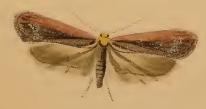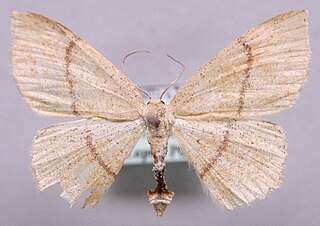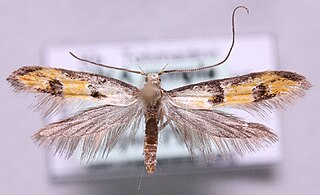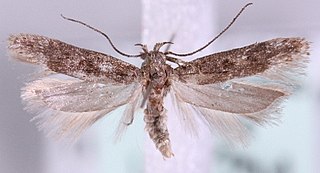
Hornets are the largest of the eusocial wasps, and are similar in appearance to their close relatives yellowjackets. Some species can reach up to 5.5 cm (2.2 in) in length. They are distinguished from other vespine wasps by the relatively large top margin of the head. Worldwide, 22 species of Vespa are recognized. Most species only occur in the tropics of Asia, though the European hornet is widely distributed throughout Europe, Russia, North America, and north-eastern Asia. Wasps native to North America in the genus Dolichovespula are commonly referred to as hornets, but all of them are actually yellowjackets.

Wolf spiders are members of the family Lycosidae. They are robust and agile hunters with excellent eyesight. They live mostly in solitude, hunt alone, and usually do not spin webs. Some are opportunistic hunters, pouncing upon prey as they find it or chasing it over short distances; others wait for passing prey in or near the mouth of a burrow.

Arctia festiva, the hebe tiger moth, is a moth species of the family Erebidae. Some authors have separated it in a monotypic genus Eucharia. It is found in Central and Southern Europe, Near East, Iran, Central Asia, European Russia, Southern Siberia, Mongolia and China.

Syngrapha microgamma, the little bride looper moth, is a moth of the family Noctuidae. The species was first described by Jacob Hübner in 1823. It is found in much of Canada south in the east to southern Maine, northern New York, and the Great Lakes states. In Europe, it is found from Fennoscandia and central Europe east to mountains eastern Asia.
Hecatera cappa is a species of moth of the family Noctuidae. It is found in Morocco, Algeria, central and south-eastern Europe, Turkey, Transcaucasia, Israel, Lebanon, Jordan, Iran and central Asia.
Leucania zeae is a species of moth of the family Noctuidae. It is found in North Africa, southern Europe, Turkey, Israel, Iran, Iraq, Saudi Arabia, central Asia and western China.

Heliothis ononis, the flax bollworm, is a moth of the family Noctuidae. The species was first described by Michael Denis and Ignaz Schiffermüller in 1775. It is found in China, Kazakhstan, central Asia, northern Mongolia (Khangai), the Russian Far East, the Korean Peninsula, southern European part of Russia, southern and central Europe, southern and eastern Siberia and Turkey. In North America it is found from south-central Manitoba west to British Columbia, north to the Northwest Territories and Yukon and Alaska and south to Colorado.

Blunt’s flat-body or purple carrot-seed moth is a moth of the family Depressariidae. It is found in most of Europe. It is also found in the Near East, North Africa, the eastern part of the Palearctic realm and since 2009 in North America. In the former USSR, it is distributed in the entire European part except for the Far North. It is also found in the northern Caucasus and Transcaucasia, in Kazakhstan, Central Asia, the south of Siberia, and the Russian Far East. It is an introduced species in North America, where it has been reported from Québec and Ontario.

Elophos vittaria is a moth of the family Geometridae first described by Carl Peter Thunberg in 1788. It is found in two separate areas in Europe. Subspecies mendicaria is found in the Alps and Mountains in central Europe, while subspecies vittaria is found from Fennoscandia, east through Russia and Asia to Japan.

Manulea pygmaeola, the pigmy footman, is a moth of the family Erebidae. It is found in the western half of the Palearctic realm, east to Altai.
Coleophora festivella is a moth of the family Coleophoridae. It is found in Algeria and southern Spain.

Cyclophora quercimontaria is a moth of the family Geometridae. It is found from southern Scandinavia to central and southern Europe and from western Russia to the Caucasus, northern Iran and the northern parts of Asia Minor.
Heinemannia albidorsella is a species of moth of the family Elachistidae. It is found in southern France and on Corsica and Sardinia.

Heinemannia is a genus of moths of the family Elachistidae.

Heinemannia laspeyrella is a species of moth of the family Elachistidae. It is found in northern, central and eastern Europe. In the east, the range extends up the Ural and in the south to Siberia.

Synopsia sociaria is a species of moth in the family Geometridae. It is found from the southern part of central Europe to western Central Asia. In the north, the range extends from the North Sea coast to the Baltic region and Russia. In the Caucasus, subspecies S. sociaria unitaria is found.

Idaea aureolaria is a species of moth of the family Geometridae. It is found from Spain and France through central Europe to the Balkan Peninsula and east to Siberia. It is also found from Turkey to Central Asia.

Scrobipalpa salinella, the sea-aster groundling, is a moth of the family Gelechiidae. It is found Europe, along the coast and in inland halophytic habitats. In the east, the range extends through Siberia and Central Asia to Mongolia. It is also found in North Africa.

Rhipiceridae is a family of beetles found worldwide. The larva of rhipicerids are parasitoids of cicada nymphs. Rhipiceridae and Dascillidae form the super family Dascilloidea, within the Elateriformia.













